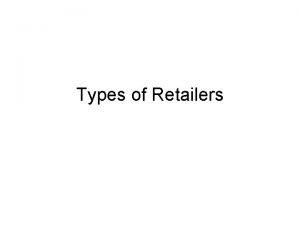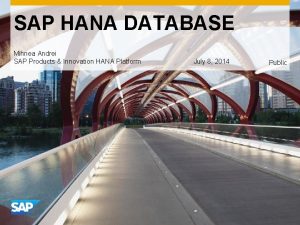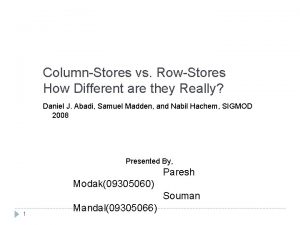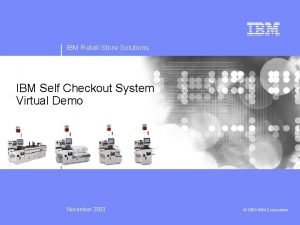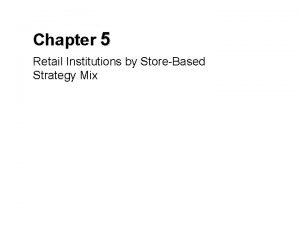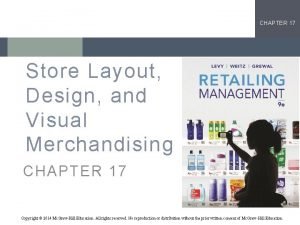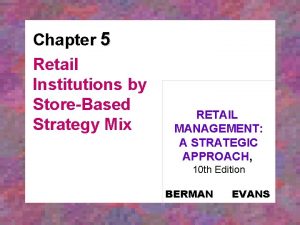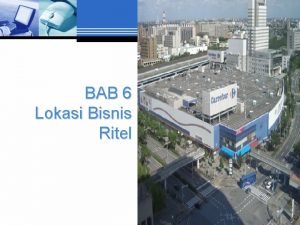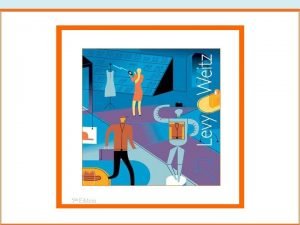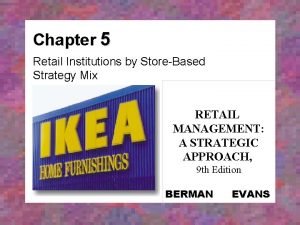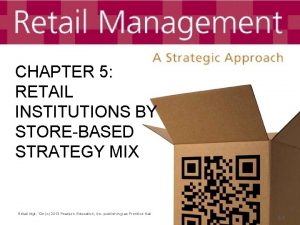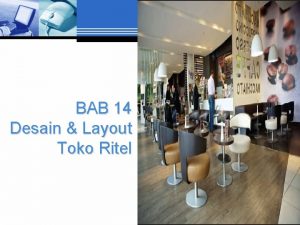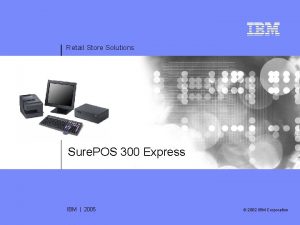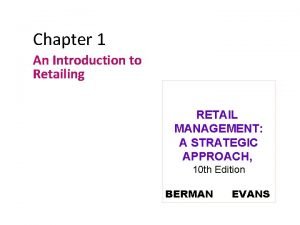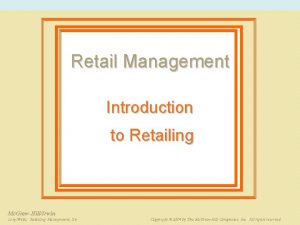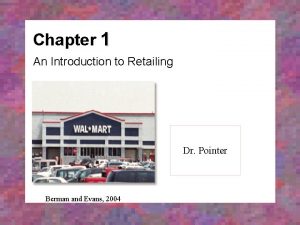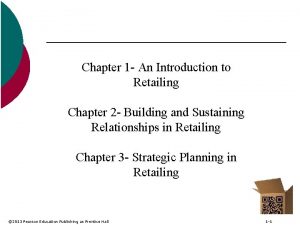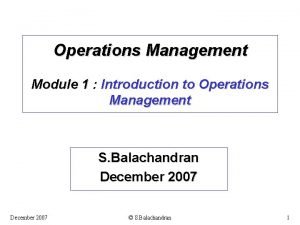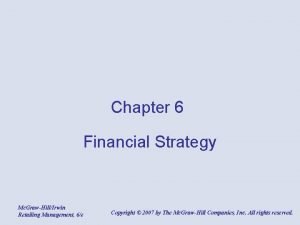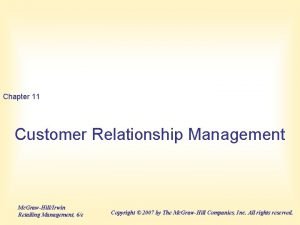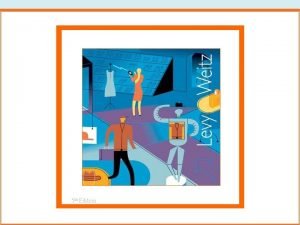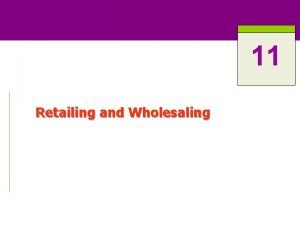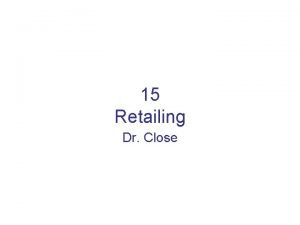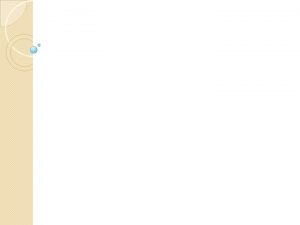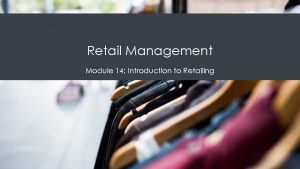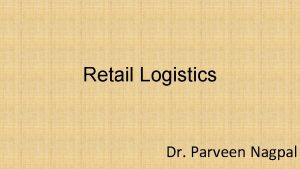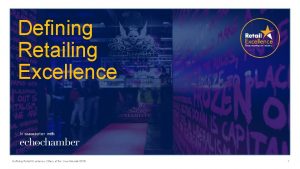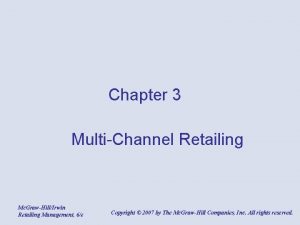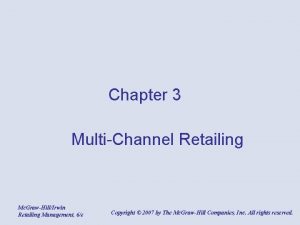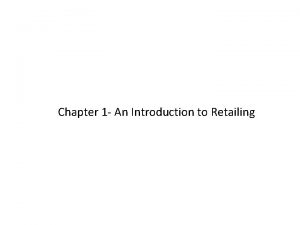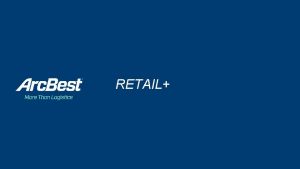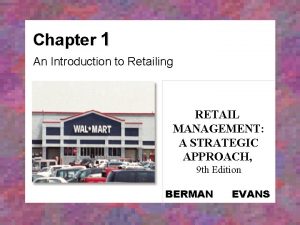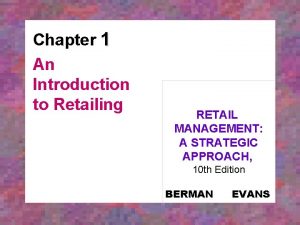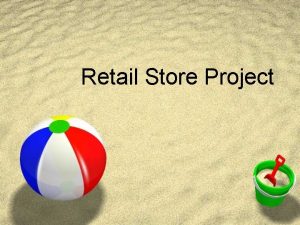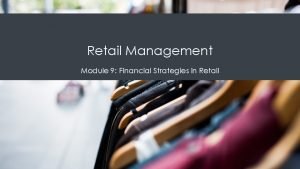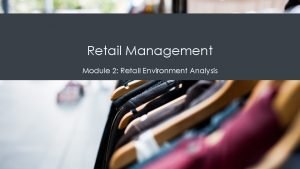Retail Management Module 13 Introduction to Retailing Store

























- Slides: 25

Retail Management Module 13: Introduction to Retailing

Store Design

Learning Outcomes: Store Design 13. 1 Identify the key objectives of good store design • 13. 1. 1 Explain how store design can create a positive shopping experience for customers • 13. 1. 2 Use an example of store design that would likely impact sales • 13. 1. 3 Describe how a store can use design to control costs

Learning Outcomes 13. 2 Explain the value of a thoughtful store layout • 13. 2. 1 Describe customer shopping behaviors and traffic-flow patterns • 13. 2. 2 Compare and contrast various store layout designs • 13. 2. 3 Explain how a retailer classifies its products into layout groupings

Design and the Shopping Experience Common Store Layouts Grid: maximizes space, allows for use of walls, corners • Used by drugstores Angular: best used for high-end products and minimal inventory • Used by Jewelry or high-end clothing stores Geometric: if Millennials are target customers • Department stores Racetrack, forced path, mixed

Design and Sales IKEA Case Study in Leveraging Store Layout

Design and Costs Angular • Allows for display of minimal amount of merchandise Diagonal • Allows for maximum amount of merchandise • Allows for easy monitoring of shoplifting or theft Grid • Allow for maximized promotions • Manufacturers “sponsor” promotions with additional cash, paying for premium and therefore saving the price

Customer Shopping Behaviors Customers can only buy what they see. If the layout doesn’t encourage them to move past what you have on display they aren’t going to buy it Shoppers enter and almost always turn right, avoid upper and lower floors, hate narrow aisles, need to orient prior shopping experience.

Store Layout Designs What are the pros and cons of each layout? Grid layout Racetrack or Loop layouts Mixed, free flow layouts

Product Layout Three rules of visual merchandising: 1. Make it visible 2. Make it tangible and accessible 3. Give customers good choices Bundled grouping: allows for items to be presented together Complementary grouping: sell different items that go together, but sold adjacently Prop groupings: mannequins created to show clothing

Rewarding Shopping Experiences

Learning Outcomes: Rewarding Shopping Experiences 13. 3 Illustrate how the store environment can create a rewarding shopping experience • 13. 3. 1 Describe why a store's exterior influences its image • 13. 3. 2 List the benefits and drawbacks of each presentation technique • 13. 3. 3 Outline the important aspects interior store design

Store Exterior • • • Endcaps: found in grid layout stores, at end of square aisle fixtures • • Short set of tables or cardboard shelving Used to promote single brand in store, or season Window displays: made up of items carried in store, viewed by passers-by • Goal is to get people outside the store, inside and shopping Promotional aisles: trick is that items usually do not feature items normally carried • • Common in stores with weekly/monthly ad sent to homes Shelf talkers that say “New Product” or “Sale!”

Store Exterior (cont. ) • • Shippers/manufacturer displays: provided to draw extra attention to a product Dump bins: meant to give impression that an item has been deeply discounted • • Nothing fragile or high quality Flip-flops on sale for start of summer, DVD bins Point of sale/purchase: last effort to sell something more to shopper • Gums and mints sold at checkouts Retailers find new ways every day to display merchandise, but many aren’t well-known or researched

Activity: Presentation Techniques With a partner, make a list of all the presentation techniques that are listed in this module. Aim to have at least five on your list. Now do a search on the internet to find photos of displays of each kind of presentation. You may have to search for specific stores or brands to find photos. Put the URLs of the webpages that you find.

Store Interior Design Flooring: makes statement (carpet, tile, wood) • Tile: allows retailer to bring in brand colors • Wood: outdoorsy or natural message • Cement: economical, stylish, versatile Lighting: warm, cool, natural, fluorescent • General/ambient: main source of light • Warm: more intimate, special shopping experience • Task: more intense light • Accent: creative drawing attention • Decorative: adds atmosphere

Store Interior Design (cont. ) Walls and Floors Colors influence emotions • Blue = calming, green = freshness, white = cleanliness, pink = energetic, purple = creative, orange = hunger, yellow = happy • Mean different things in different cultures Other elements: • Furniture/fixtures: industrial • Fitting rooms • Decorative items

Atmosphere in Web Retailing

Learning Outcomes: Atmosphere in Web Retailing 13. 4 Use nonstore-retailing atmospheric principles to analyze current web retailers • 13. 4. 1 List the characteristics of an appealing retailer website • 13. 4. 2 Describe how web retailers use design features to craft an online store • 13. 4. 3 Define UX and the role of user experience in web retailing • 13. 4. 4 Examine the advantages and disadvantages of running an online store

Characteristics of Retailing Websites Shoppers react to environment, layout, and product display Appealing website is about shoppability • Easy of use • Hi-resolution photos • Mobile-formatted site • Free shipping • User reviews • Secure payment options • Eye-catching and visually attractive

Online Store Design Layout, traffic flow, & environment are important • Appealing landing page: comparative to front of store • Enticing product pages: top menu shows items from store • Can narrow down search results (size, material, color, price, etc. ) • Bundled displays aim for increased sales conversions • Visual display techniques leveraged when crafting retail website, meaning more profit for retailer

User Experience • • Users expect a site will: • Load quickly, be easy to navigate, have good photos/search features, have concise but excellent product descriptions, offer live chat or instant customer service, have quick/secure checkout Recognizing that shopping is becoming “omnichannel”, meaning multichannel approach Voice-activated shopping experiences: Pet supply chains Subscription shopping: make it easy to offer monthly or weekly interactions with customers that surprise/delight

Pros and Cons of an Online Store Brick-and-mortar • Advantages: shopper can have entirely immersive shopping experience, where you control everything • Disadvantages: shoppers are short on time and stingy about where they spend it Online • Advantages: trends favor e-commerce, and you don’t need large sales staff or have “store hours” • Disadvantages: attention span, can damage your margin if there is free shipping

Pros and Cons of an Online Store (cont. ) • • • Advantage of having both brick-and-mortar and online store, is ability to appeal to your customer through both channels Allow you to appeal to larger variety of shopping by offering them different ways to shop merchandise Some customers will resist purchasing items online, others stick to online shopping Website can act as window display Disadvantage of both: area of retail that’s adjusting to online trends, and retailers find themselves in position where they have to shrink their store footprint

Quick Review Brick-and-mortar stores are different than online stores, but both work to maximize sales Shoppers are predictable from the way they walk through a store. Customers make 80% of purchasing decisions in store. Visual merchandising is retailer’s tool to influence customer and make more sales, meaning more margin and profit Online stores have advantages and disadvantages.
 Retail store organizational structure
Retail store organizational structure Retail communication process
Retail communication process Types of retailers
Types of retailers Row store vs column store
Row store vs column store Row store vs column store
Row store vs column store Objectives of retail store operations
Objectives of retail store operations Retail checkout lane lights
Retail checkout lane lights Retail strategy mix
Retail strategy mix Boutique layout design
Boutique layout design A retail store stocks two types of shirts a and b
A retail store stocks two types of shirts a and b Retail strategy mix
Retail strategy mix Lokasi ritel
Lokasi ritel Store layout design and visual merchandising ppt
Store layout design and visual merchandising ppt Retail institutions by store-based strategy mix
Retail institutions by store-based strategy mix Scrambled merchandising examples
Scrambled merchandising examples Grid store layout example
Grid store layout example Ibm retail pos
Ibm retail pos Retail store hierarchy
Retail store hierarchy Retail marketing chapter 1
Retail marketing chapter 1 Introduction to retailing ppt
Introduction to retailing ppt Introduction to retailing
Introduction to retailing Introduction to retailing
Introduction to retailing Introduction to operations management module
Introduction to operations management module Strategic profit model
Strategic profit model Crm process in retailing
Crm process in retailing Customer relationship management in retailing ppt
Customer relationship management in retailing ppt


